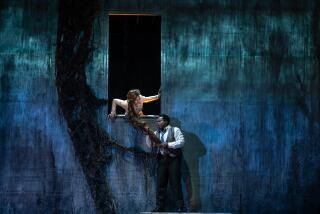1739 OPERA-BALLET : RAMEAU’S ‘FETES’ AT THE UCLA BAROQUE FESTIVAL
Three times on Saturday at the E. Nakamichi/UCLA Baroque Festival in Royce Hall, a handsome, if problematic staging of Jean-Phillipe Rameau’s 1739 opera-ballet “Les Fetes d’Hebe ou Les Talents Lyriques” offered the same historical revelation: dances absolutely integral to the prevailing dramatic conception.
Conventional wisdom and the surviving repertory largely relegate dancing in grand opera to a mere decorative function--one increasingly resented by the opera composers forced to add ballet sequences to their works. Yet while Rameau did, indeed, crown the three entrees of his work with lengthy, static dance divertissements , he also used dance elsewhere in “Les Fetes d’Hebe” with a pertinence that the lyric theater would seldom experience after him until the era of the seamless book-musical in our own century.
Considered apart from the always expert, often artful choreographies created by Catherine Turocy and Ann Jacoby for this New York Baroque Dance Company/ Concert Royal project, the ballets that Rameau placed midway through each section of “Les Fetes d’Hebe” remained indispensable to his expressive priorities: making three convoluted narratives culminate in formal celebrations of poetry, music and dance.
In the prophesy scene of “La Musique,” dance pre-figured and heightened offstage events. In the mate-choosing septet of “La Danse,” it directly advanced the plot. And in the Naiad interlude of “La Poesie,” it served, like the play scene in “Hamlet,” to allow a character to convey a hidden injustice through a theatrical depiction.
The libretto by Gauthier de Mont-d’Orge held its own surprises, among them a plot line in “La Danse” that closely paralleled Act I of “Giselle” up to the unmasking of the disguised lover. (“Giselle,” of course, was created in Paris a century later--by which time women dancers had abandoned heeled shoes for those newfangled pointe slippers.)
The unexpected historical insights hardly proved beside the point. Indeed, the educational frissons --all the links to Romantic and classical ballet, plus Shakespeare, musical comedy and even postmodern structuralism--helped sustain interest in the UCLA “Les Fetes d’Hebe” despite major artistic lapses and miscalculations.
Because the UCLA production jettisoned the original prologue (and with it both Hebe and the work’s conceptual unity), and because director Roland Jullien ignored the emotional appeal of the music and staged the operatic action like a stylized Baroque puppet show, Rameau’s essential purpose, theatrical pattern and deepest resources counted for little--despite notably vibrant, transparent playing by the Concert Royal under James Richman.
Ann Monoyios sang leading roles in each of the entrees , suggesting in the Naiadic plea of “La Poesie” and throughout “La Musique” qualities of feeling even when locked into highly conventionalized poses. In “La Danse,” she supplemented her refined vocalism with initially tentative but increasingly comfortable dancing. An artist of great warmth and intelligence.
Howard Crook made a stolid Lycurgue in “La Musique” but immediately returned as an elegant, charming Mercure in “La Danse,” capping his performance by breezing through the spectacularly florid aria “L’objet qui regne.”
Robert Osborne sang strongly as both a river god in “La Poesie” and the heroic Tirtee in “La Musique,” even managing to wear his impossible costume for the latter (a feathered Trojan helmet and breastplate over what looked like Baroque Pampers) with unshakable dignity.
Other prominent singers included Margery Daley (vocally thin as Sapho), Nathaniel Watson (opulent sounding but unprepossessing acting the lover in “La Poesie” and the Hilarion-like swain of “La Danse”) and Jeffrey Thomas (vocally agile in the brook god’s big aria in “La Poesie”).
Among the dancers, Luisa Meshekoff, James Martin, Kenneth Pierce and Jacoby skillfully executed the character solos of “La Musique,” and Turocy impersonated Terpsichore herself in “La Danse” with effortless majesty.
More to Read
The biggest entertainment stories
Get our big stories about Hollywood, film, television, music, arts, culture and more right in your inbox as soon as they publish.
You may occasionally receive promotional content from the Los Angeles Times.










